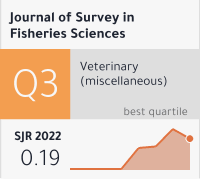The small-spotted catshark, Scyliorhinus canicula, transfer from catch to the public aquarium for the exhibition
DOI:
https://doi.org/10.17762/sfs.v7i2.130Keywords:
Small -spotted catshark, Scyliorhinus canicula, transfer, catch, public aquariumAbstract
A public aquarium (or city aquarium) is the aquatic counterpart of a zoo, which houses living aquatic animal and plant specimens for public viewing. The supply of the species to be exhibited is one of the most important issues. The small-spotted catshark (Scyliorhinus canicula), is very famous for public aquariums to the exhibition. Along the Turkish coast, bottom trawls primarily take catshark. In this study, it was aimed that live S. canicula supply and their transfer to public aquariums. Catsharks were obtained by commercial trawl at the three operations. Operations were carried out in September 2019 in Sığacık Bay, Turkey. Totally 26 S. canicula was caught and they had put into 50, 100 and 200-liter tanks for the transportation. In the transfer process, the average, ammoniac, temperature, oxygen pH value and salinity values were taken and their values are70 mg/L, 18.8 Co, 7.16 mg/L, 8.03 and 39.8 ppt, respectively. At the end of the 3-hour transfer period, all of the fish were successfully transferred to the quarantine process. After 1 week quarantine period, the fish were put into the aquarium to be the exhibition. Mainly ammonia the other transfer water criteria such as temperature, oxygen pH value and salinity are important for transportation. Because S. canicula start to release ammonia when get stressed. Therefore, water criteria should be checked every 30 minutes and if necessary Amquel for ammonia bicarbonate for pH added in transfer tanks. After 1.50 h later, all individuals were successufully transported as live (100% survival rate) to the quarantine process.










